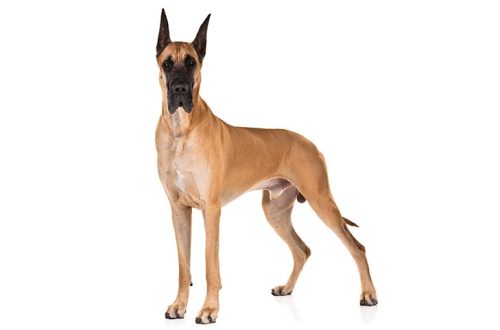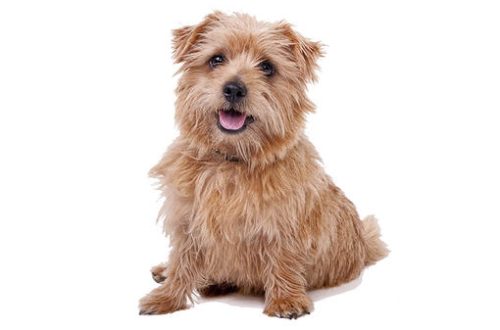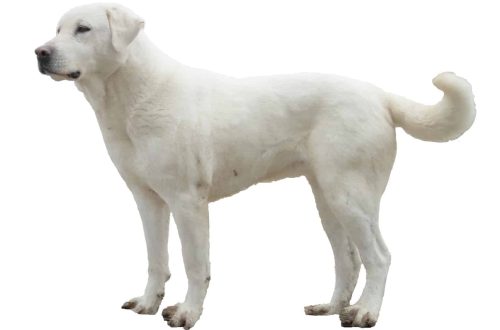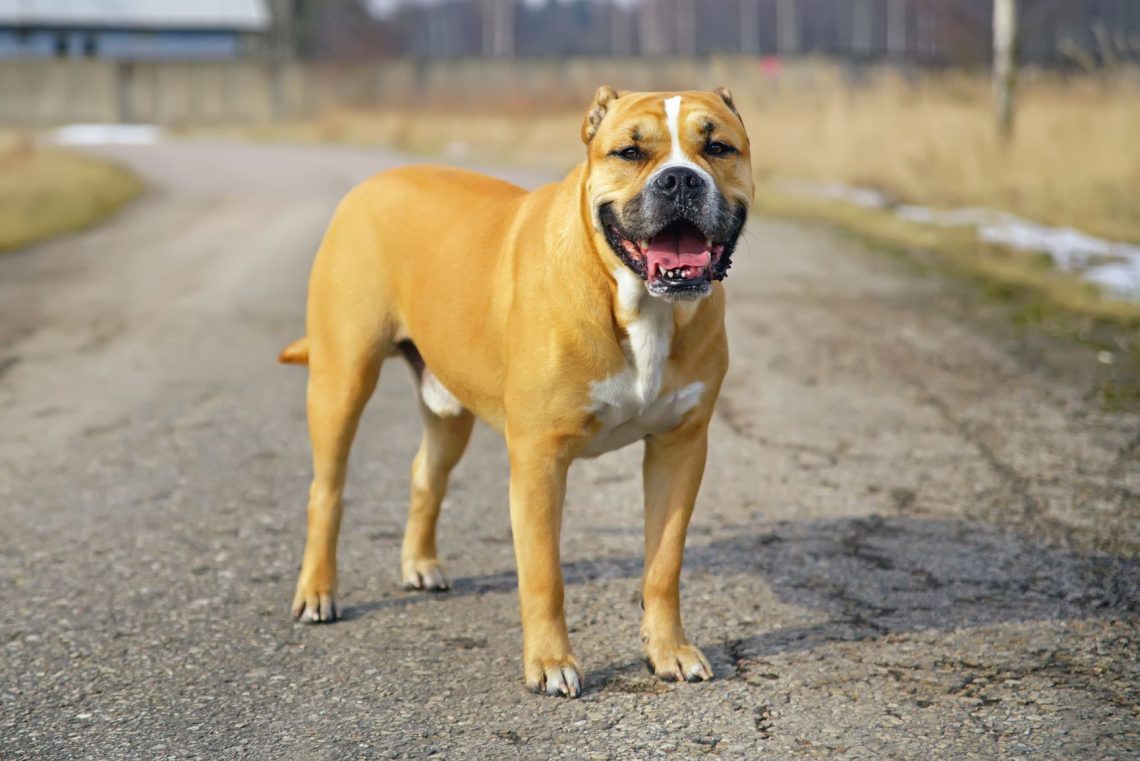
Ca de Bou
Other names: Majorcan Mastiff , Majorcan Bulldog , Perro Dogo Mallorquin
Ca-de-bo is a noble knight of Spanish origin. His character combines restraint, courage and devotion – the best qualities of a pet that is destined to become an indispensable friend!
Contents
Characteristics of Ca de Bou
| Country of origin | Spain |
| The size | Small |
| Growth | males 55-58 cm, females 52-55 cm |
| Weight | 30 to 38 kg |
| Age | 10-12 years |
| FCI breed group | not reconized |
Basic moments
- The Mallorca Mastiff is a unique breed: its formidable appearance is whimsically combined with a kind heart and docile disposition.
- Ca-de-bos are not inclined to single out favorites and show tenderness towards each member of the family, no matter how numerous it may be.
- The phlegmatic nature of the dog helps her come to terms with forced loneliness: she will simply go to bed waiting for the owner.
- Thanks to their excellent watchdog qualities, representatives of the breed easily cope with the duties of a security guard.
- Ca-de-bo love the company of children. With no less condescension, they treat pets.
- Mallorca mastiffs need a strong and responsible leader who is able to properly organize the processes of education and training.
- Contrary to popular belief, these Molossians are very active and mobile, and therefore require long walks.
- Ca-de-bo are not suitable for keeping novice dog breeders.
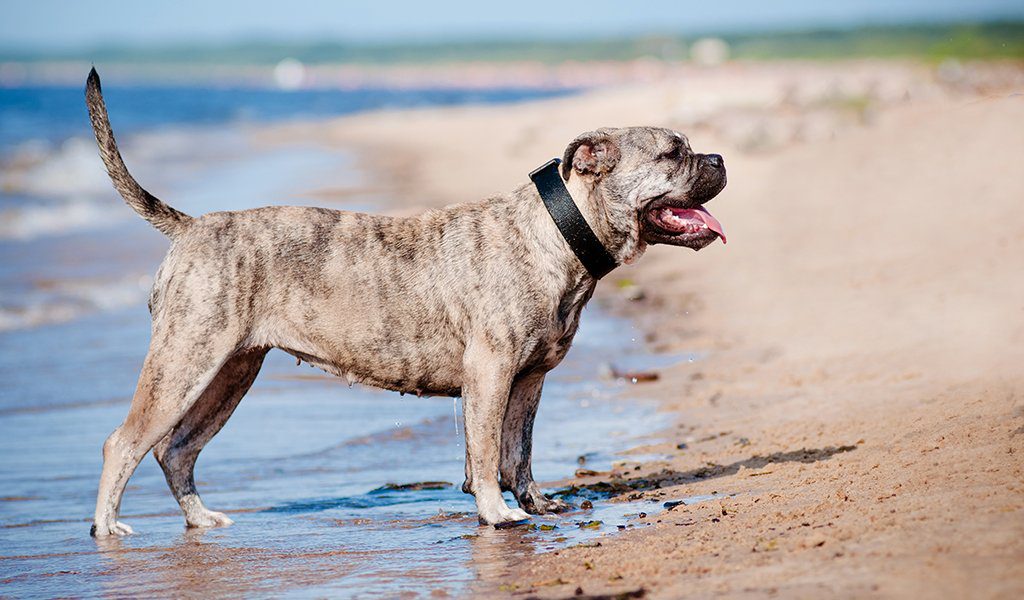
Ca de Bou are representative and serious Molossians, who are able to make a lasting impression. Only a few guess: under the powerful dimensions of the dog, the character of a good-natured healthy man is hidden. These animals are not aggressive towards strangers, they treat children with tenderness, and pets with patience. At the same time, magnificent bodyguards are obtained from ca-de-bo. Despite the fighting past, dogs tend to soberly assess the situation before attacking the enemy. A well-bred Molossian is hard to provoke, but if he is still seized with rage, the dog will turn into a time bomb. The offender will hardly be able to emerge victorious from an unequal battle with such a hardy animal.
History of the ca de bou breed
The history of the origin of the Spanish Molossians dates back to the first half of the 13th century, when the Aragonese king Jaime I the Conqueror defeated the Almohad Moors. They were forced to liberate the Balearic archipelago – a vast territory that included fifteen islands (four large and eleven small in size). On the largest piece of land, the kingdom of Mallorca (Majorca) was founded, which became an Aragonese vassal. According to the generally accepted theory, it was here that the first ancestors of the ca-de-bo appeared – the Molossian dogs brought by the Aragonese, and later by the inhabitants of other states.
Possible progenitors of the breed include Spanish Mastiffs and Bulldogs, Dogue de Bordeaux , Pyrenean Mastiffs and English Bulldogs . Among the potential ancestors of the Molossians, mastiffs are also mentioned, brought to the Balearic Islands by the army of Jaime I. Uncontrolled matings led to the emergence of new guard-fighting dogs. They were called Ca-de-Bestiar. Often cynologists compare this name with the word “beast” (rogue, rogue), but such a judgment is erroneous. Translated from the Catalan language, “ca de bestiar” – “a dog that drives cattle.”
In addition to the main function, the animals successfully coped with the protection of port warehouses and residential premises. The physical qualities of these dogs were highly valued by local aristocrats, who used Molossians to hunt wild boars, bears and other large game. Despite the fact that the dogs differed from each other in size and hardly stood out in one breed, their popularity did not decrease. At the beginning of the 18th century, it acquired a more cruel meaning.
The Treaty of Utrecht, signed in 1713, ended a major European conflict, the War of the Spanish Succession. The Balearic Islands became a British colony. The British “shared” ideas of leisure with the locals. Then he was famous for cruelty and meant participation in an underground sweepstakes during dog fights and baiting large animals. The inhabitants of Mallorca adopted the bloody experience of the British, and by the end of the 18th century, cruel ideas grew into a fanatical love for bullfighting.
Unlike the modern show, which consists of a battle between a bullfighter and a bull, the original version was very dangerous and was therefore revered by the Spaniards. So, an unarmed man accompanied by a dog entered the arena to an angry animal, from which one thing was required – to protect the owner at the cost of his own life. Mallorca Molossians were unsuitable for bloody entertainment. They died from their wounds in the first minutes of the bullfight or inflicted heavy injuries on the bull, making the show less spectacular. So there was a need for breeding dogs for baiting.
Old English Bulldogs would be ideal participants in bloody performances, if not for their embittered and uncontrollable nature. To create a balanced breed, the Spaniards crossed bulldogs with Ca de Bestiar dogs. The result of the selection was animals that were very reminiscent of modern Mallorca Molossians. They were used as four-legged gladiators until the middle of the 20th century (first in bull-baiting, and after its ban in 1883, in dog fights).
The first representatives of the breed were subjected to severe selection. During problematic births, bitches most often died without receiving help from the owner. Weakened puppies were not cared for, and strong and healthy puppies were not protected from viral diseases. The Spaniards did not bother themselves with raising pets: this task was completely assigned to the bitch, who instilled socialization skills in the puppies. Aggressive or cowardly dogs were destroyed; they did not leave alive the Molossians, who were seriously injured in battles.
Such a radical approach led to natural consequences. On the one hand, modern representatives of the breed are famous for their good health, remarkable strength and calm character: the gene pool has lost its negative qualities over time. On the other hand, the irresponsibility and careless attitude of the Spaniards towards dogs endangered their continued existence. So, by the beginning of the 20th century, the number of pickling molossians was limited to a few dozen.
In addition to the fighting pits, the animals were still used in a few livestock farms. The versatility of dogs was the main reason why Spanish breeders thought about increasing their numbers. The breeding program, as before, provided for the mating of Ca-de-Bestiare (mainly brindle) and Old English Bulldogs. This time the breeders paid attention to the exterior of the animals. The small size indicated the dominance of the “English” genes, and the impressive dimensions indicated a close relationship with the shepherd Molossians.
Suitable material for selection were specimens of medium size, which were quite rare. Despite this, the breeding work brought worthy results: in 1923, the Mallorca Molossians were entered in the register of the Stud Book of Spain as a ca-de-bo. The name of the breed appeared at the beginning of the century, when the president of the club of Bordeaux dogs spoke of animals as quite promising participants in persecution. In 1929, a representative of the new breed appeared for the first time at an exhibition in Barcelona.
A year after the end of the Second World War, the ca de bou standard was developed, but the registration of Mallorcan dogs by the FCI organization took place only in 1964. Firstly, the Balearic breeders were still interested in the physical data of the Molossians, so animals with full compliance with the standard were quite rare. Secondly, in the 20th century, other breeds were at the peak of popularity: the German Shepherd and Great Dane, as well as the Rottweiler. Dog breeders showed interest in Ca-de-Bou after the 1980s. At the same time, most lovers of Mallorcan Molossians lived on the territory of Poland and Russia: for example, in Moscow by 1990, more than 2 thousand ca-de-bos were registered.
In other European countries – Sweden, Finland, Denmark – the breeders of these dogs were much less common. In the USA and Canada, the popularity of Molossians was negligible. A similar situation is observed now: Ca-de-bos are found mainly in Europe (least of all in its western part).
Video: Ca-de-bo
Ca de bou breed standard
Being a medium-sized breed, Ca de Bou are notable for their strong build and slightly elongated body format. The dogs impress with their mobility and plasticity – especially for those who see Majorcan Molossians for the first time.
The height at the withers and the weight of the animal are fixed by the FCI standard. The growth of males and females reaches 55-58 cm and 52-55 cm, respectively. The difference between male and female individuals is also noticeable in weight: 35-38 kg and 30-34 kg. Sexual dimorphism can be traced not only in the size of the animal: the girth of the head in females is much smaller than in males.
Head and skull
Ca-de-bo has a square head; its circumference coincides with the circumference at the withers. The shape of the skull is also close to a square, the back is not visible when viewed from the front. The forehead is divided by a furrow and looks wider than the barely pronounced occiput. The cheekbones are powerful, chewing muscles reach the level of the eyes. The upper lines of the skull and muzzle are parallel.
Muzzle
The muzzle is cone-shaped, not pointed; the base is wide. The length is equal to one third of the length of the skull. Any amount of skin folds is acceptable. The stop appears sharp when the head is turned in profile; invisible from the front, and the reason for this is the superciliary arches. The bridge of the nose is straight or slightly upturned. The lobe is pigmented black. The upper lip is dry and tight, the lower lip is looser, forming a small fold in the middle. The teeth, including the front incisors, are not visible even when the animal’s mouth is closed. The mucosa is colored red, transverse ridges are visible on the palate. The gums have a black border.
Ears
A wide and high set is visible, as well as a pink shape: the ears are broken in the cartilage and expose the ear canal. Most of the time, the rounded tips are at or below the eye line. If the animal is alarmed, the ears rise and turn slightly forward.
Eyes
Quite large eyes ca-de-bo oval, have an oblique cut. Planted “like a bulldog”: deep and at a great distance. When the dog’s head is turned full face, the whites of the eyes are hidden by dense eyelids with black edging. A dark color of the iris, corresponding to the color of the coat, is preferred. Eyebrows are weakly expressed.
Jaws and teeth
The jaws of the Majorcan Mastiff form a bulldog bite (undershot). The gap between the teeth does not exceed 10 mm. The incisors are located on the same line, the fangs are distant from each other.
Neck
Powerful and strong, in proportion to the body of the dog, smoothly merges into a pronounced withers. The skin is loose, a slight dewlap is acceptable. The diameters of the base of the neck and head are the same.
Frame
The body of the Ca-de-Bou is rectangular in shape (which is typical of Molossian breeds), moderately elongated, with strong muscles. The massive chest has the shape of a cylinder, reaches the level of the elbows and expands at the withers. The back is almost parallel to the ground. The short and wide loin turns into a sloping croup set at an angle of 30° and rising 1-2 cm above the level of the withers.
Tail
Tapers from root to tip, set rather low. Usually lowered, not reaching the hocks. When the dog moves, the tail rises to the line of the back, forming a smooth curve.
Forelimbs
Notable for their wide set due to the massive chest, parallel. The shoulders of the Ca-de-Bou are slightly arched and short, slightly sloping. In the area of the forearms, relief muscles are noticeable. The elbows are not close to the chest, but they are not turned out to the sides either. Feet are strong and rounded, with well-knit toes. Pigmentation of the pads is weakly expressed.
Hind limbs
They are notable for their more powerful muscles in comparison with the front ones. Thighs of medium size, very wide; knees set at a natural angle. Short shins pass into straight metatarsus. The latter end in oval paws with elongated fingers. The pads are painted in a dark shade. The presence of dewclaws is not welcome.
Movement style
Ca-de-bo move at a trot, alternately rearranging pairs of limbs located diagonally.
coat
Short and harsh coat fits snugly to the body of the animal. The undercoat is missing.
Color
There are three main colors of ca-de-bo:
- brindle – both dark and lighter (marble) options are acceptable;
- red (fawn, deer) – deep saturated shades are desirable;
- the black.
White points are allowed by the standard if they occupy no more than a third of the body area. Some Majorcan Mastiffs have a noticeable “mask” framing the muzzle.
Possible vices
According to the definition, a breed defect is the slightest deviation from its standard. In the case of Ca-de-bo they call:
- incomplete dental formula with missing premolars;
- the difference between the height at the withers and the sacrum in favor of the first;
- the gap between the upper and lower teeth is more than 10 mm;
- ears atypical for the breed (erect or hanging);
- scissor or level bite;
- bulldog tail.
Mallorca Mastiffs are disqualified for the following reasons:
- light or yellow pigmentation of the iris;
- white spots covering more than 30% of the body;
- aggressive or timid behavior;
- cropped ears or tail;
- points of any color;
- undescended testicles;
- undershot bite
Ca-de-bo character
The fighting origin of the breed has led to numerous stereotypes associated with the ca de bou. Frightening stories about the bloodthirstiness of dogs are the result of a lack of socialization or improper upbringing (including the deliberate development of aggression). In fact, these are psychologically stable, restrained and calm animals that do not insist on constant communication. A friendly giant will gladly take a place near the owner and, closing his eyes, will go in a dream in search of his favorite delicacy.
Mallorcan mastiffs easily join the collective called “family”. Dogs equally respect and love close people, subtly feel the prevailing atmosphere, show an amazing ability to rejoice and empathize with random events. Ca de bou are not inclined to give obvious preference to one person, thus rewarding him with the honorary title of host. This quality makes the animals suitable for keeping in any “company” – whether it be a married couple with a child or an elderly couple.
Being phlegmatic by temperament, Mallorca mastiffs do not see anything wrong in being forced to be alone. The dog will patiently wait for your return from work, without disturbing the neighbors with loud barking or, worse, howling. A comfortable lounger, a bowl filled with food and a favorite toy – three faithful “comrades” will help anyone pass the day while waiting for the owner!
Representatives of the Molossian breed need an experienced and responsible leader who will consistently build a trusting relationship with the pet. Mallorcan mastiffs are quite capricious and persistent. Dog owners note that the peak of ca-de-bo obstinacy falls on a transitional age and the so-called estrus – an approving reaction of a bitch to the presence of a male. The Mastiff is inclined to defend his “point of view” to the last: if the bed seems more comfortable to him in comparison with the sunbed, you will have to make tremendous efforts to get rid of the unwanted neighbor.
Distrustfulness and a tendency to defend one’s territory is a suitable foundation for the development of the protective qualities of the ca-de-bo. From representatives of the breed, you can bring up vigilant and courageous defenders. Molossus will not attack a stranger if he invades the personal space of the family with the permission of the owner. The absence of the owner is a good reason to arrange a game of peepers for a stranger and, if necessary, rush to the attack. A course with a professional cynologist will help to improve the watchdog qualities of a dog – in the event that you do not have enough experience.
Despite the potential danger that guard mastiffs pose, their kind heart melts next to a child. Ca-de-bos are distinguished by iron patience and therefore take part in games with a little friend to the best of their ability – and even if this is fraught with painful pokes. However, it is still worth following a fun company: while frolicking, a dog can accidentally push a child – quite painfully, given the impressive size of the animal.
Mallorca mastiffs are loyal to their relatives (the exception is males, which share the territory among themselves). They are no less friendly towards cats, but it is better to refrain from the company of decorative birds and rodents. Although ca-de-bos do not show hunting instincts, “communication” with pets of small sizes can end in unpleasant consequences. If the small animals appeared before the Molossian, keep their contact to a minimum as much as possible.
Representatives of the breed are very mobile, love long walks and fun games in the fresh air. Ideally, the owner of the Majorcan Mastiff should be an active person who is not afraid of the daily promenade through the city park. Don’t forget to take a ball or frisbee with you – and the ca-de-bo will show everything he is capable of!
Education and training
Future owners of Mallorca Molossians should remember: it is customary to start “working” on the behavior of a four-legged friend from the first day of his appearance in the house. Stock up on a huge amount of patience and time – you cannot do without them in education and competent socialization. Primary skills of interaction with the surrounding world Ca-de-bo are obtained in nurseries. It is at this time that dogs will have to learn to build trusting relationships, and not dictate their terms through an ultimatum.
Cynologists recommend combining the “human” upbringing of a puppy with a “dog” one. To do this, babies must be periodically left in the company of other, older dogs. In the case of males, this can turn into a fight: even a six-month-old male is capable of sorting things out through teeth and claws.
When raising a puppy, do not allow him to do what you would not want to see in an adult dog. Ca-de-bo behavior is best corrected in the first year of life. More mature individuals are practically not amenable to re-education and tend to take a dominant position in your “pack”. If you feel that it is becoming more and more difficult to cope with an obstinate pet, seek help from a cynologist.
Successful training of Majorcan mastiffs is possible with the right approach to business. It will not be difficult for people with experience in keeping dogs to teach a pet basic commands, while beginners will need the intervention of a specialist. Ca-de-bo owners recommend taking a course of ZKS (protective guard service), which will help develop the protective qualities of the animal.
Important: encouraging aggression is a direct way to raising an embittered pet. Since the ancestors of the Molossians were used as universal “soldiers” for fighting pits, it is worth abandoning rough training methods.
Future participants of the show need to think about handling – the art of showing a dog during a show. The training course will allow you to focus on the merits of the Ca-de-Bou and thereby hide the possible shortcomings of the animal. Depending on the style of handling (English, American or German), the specialist will be able to “assemble” the Majorcan Mastiff in parts, like a designer. This will greatly increase the dog’s chances of winning.
Please note: when using the services of a handler, make sure that he teaches your pet to move in a well-coordinated trot and be patient with inspection. The latter most often includes palpation, as well as a check for cryptorchidism and the presence of a complete dental formula.
Care and maintenance of Ca de Bou
Mallorca Mastiffs do not require much grooming. Like all short-haired dog breeds, Ca-de-Bou retain a presentable appearance for a long time. The effect will be enhanced by regular combing of the “fur coat” of the animal: no more than twice a week. As an aid, use a massage brush with thick natural bristles (an analogue made of rubber is also suitable). Molossian wool is combed out more often during the molting period. This procedure can also be done outside if the weather permits. So you save yourself from wet cleaning in an attempt to eliminate numerous hairs.
Bathing is a stumbling block for Ca-de-bo owners. Wanting to prevent the possible appearance of the smell of “dog”, the owners of the Mallorcan mastiffs arrange a weekly bath day for their pets (or even more than one). Due to frequent water procedures, a thin protective layer is washed off the dog’s coat, and the work of the glands is activated, disrupting the natural fat balance of the skin. This leads to rapid contamination of the coat, and it, in turn, to the appearance of an unpleasant odor.
Remember: you need to bathe your pet as little as possible! It is advisable to avoid this, in extreme cases, minimize the number of procedures to one or two per month. Use hygiene products with a low content of acids and alkalis, paying attention to the line for rough-haired dog breeds. In rare cases, dry shampoo is also suitable, which is rubbed into the coat and then combed out with a brush.
The anatomy of the ca de bou is the main reason why members of the breed rarely experience ear infections, but a preventive examination is still mandatory. Check and clean (as needed) your dog’s ears daily. Helpers in this matter will be cotton swabs or discs moistened with a drying agent from a pet store. It is not recommended to use special sticks: careless hand movement can damage the eardrums.
The eyes of the animal are also subjected to daily inspection. If there are foreign particles, carefully remove them with a sweeping motion towards the inner corners. A special lotion acts as an auxiliary; Strongly brewed tea is also suitable. In case of redness of the eyes, tearing or souring, you should contact your veterinarian.
The oral cavity of the ca-de-bo needs more careful care. The reason for this is a snack, which favors the formation of plaque and tartar. This can be avoided by preventive cleaning – both in the veterinary clinic and at home. In the latter case, you will need hard treats made from compressed bones and rubber toys.
To fully remove plaque, it is necessary to brush the animal’s teeth no more than twice a month. More frequent procedures are fraught with damage to the enamel. Use an old brush or compact finger tip. When choosing a hygiene product, stop at special zoopastes with a neutral taste. The use of “human” analogues can cause an allergy in a ca-de-bo.
For your information: dry food also contributes to the mechanical cleaning of the teeth.
An equally common misconception among novice dog breeders concerns the claws of an animal, which supposedly wear down naturally. In fact, the owner’s intervention is mandatory: a long “manicure” changes the dog’s gait, making it difficult to move. Individual cases are fraught with deformation of the fingers of the fore and hind limbs. To avoid problems, shorten your pet’s nails with a guillotine-type nail clipper. A nail file will help smooth out burrs and jagged edges.
An impressive niche in the care of the ca-de-bo is occupied by feeding. Breeders who specialize in breeding the breed recommend choosing one of two options: industrial food (premium and super-premium classes) or dietary natural food. Diet is especially important in puppyhood, when the Mallorca mastiff is prone to accelerated weight gain.
Please note: the use of natural products is always combined with the intake of vitamin supplements. At the same time, the period of changing teeth requires a more careful dosage. The alternation of several vitamin complexes is mandatory, so before purchasing one or another supplement, you should consult with a specialist.
A natural ca de bou diet should consist of one to two thirds of meat: lean veal or beef, chicken or turkey. Choose sinewy pieces – they favorably affect the digestion of the animal. Offal and raw frozen fish – sea or ocean – are suitable as a source of protein.
Seasonal fruits and vegetables, fermented milk products and eggs serve as an addition to the natural “menu” of the Mallorca Mastiff. To improve the condition of the dog’s coat and skin, it is necessary to add a tablespoon of vegetable oil (linseed, sunflower, corn or olive) to food daily.
Be sure to exclude from the diet:
- fatty meat (boiled pork is acceptable in small quantities);
- raw cabbage, beans and peas (cause bloating);
- foods high in carbohydrates;
- pickles and products with spices;
- fried and smoked food;
- river fish in any form;
- berries with seeds;
- sweet and flour;
- tubular bones;
- whole milk.
Provide Ca-de-Bou with regular access to fresh drinking water – preferably bottled. It can be replaced with a flow one, having previously insisted for more than 6 hours. The use of boiled water is not recommended.
The average size of the Mallorcan mastiff makes them versatile in terms of keeping. Dogs feel comfortable both in an apartment and in a private house with a fenced area. In the latter case, the ca-de-bo satisfies its needs for physical activity. Keeping an animal in an apartment implies daily walking (about an hour at least twice a day). Walks should be moderately active – with elements of agility and more familiar sports games.
Health and disease Ca-de-bo
Brutal natural selection among Majorcan Mastiffs has resulted in a healthy breed with strong immunity and minimal susceptibility to common diseases. However, Ca-de-bo still have a predisposition to certain ailments. Among them:
- sensitivity of the digestive tract;
- food allergy;
- joint dysplasia;
- hepatopathy;
- demodicosis;
- myositis.
Timely contact with the veterinary clinic is the key to the longevity of your pet. An equally important point is prevention: take care of vaccination, treatment for external parasites and deworming.
How to choose a Ca de Bou puppy
The search for a future four-legged friend must begin with official nurseries that specialize in breeding ca-de-bo. It is also worth checking the breeder’s reputation, as you will have to maintain feedback with him in matters of keeping the dog. Decide what goal you are pursuing: acquiring a faithful companion or a future champion. In the latter case, the help of an expert will be required, who will establish the conformity of the animal to the breed standard.
The second stage is getting to know the parents of the puppies. Closer contact with adult ca-de-bo will help to determine the presence of defects that will appear in the future in the litter. Familiarize yourself with the conditions for keeping dogs, ask the breeder about awards and titles (if this is important). Only after clarifying the nuances, you can begin to examine candidates for the role of your friend.
When choosing, focus on individual points.
- The appropriate age for a puppy to be adopted into a new family is 1.5-2 months. The baby has already formed the basic skills of interacting with the outside world. It is worth noting that all puppies are subject to an initial examination by the breeder no earlier than 30-40 days. Already at this time, it is possible to establish compliance with the Ca-de-Bou standard.
- A bump on the animal’s head is one of the “indicators” of future growth. The larger it is, the taller your pet will be.
- The coat of the Molossian should be uniform and clean, the eyes and ears should be free of discharge, the tail should be free of creases.
- A healthy puppy is active, shows interest in the world around him and is happy to “get acquainted” with new things for him. Aggression or cowardice are alarm bells: a balanced dog will not grow out of such a baby.
- Ca-de-bo behavior largely depends on gender. Males often show self-will and independence in comparison with females – more affectionate and accommodating.
When buying a puppy, the breeder must provide a veterinary passport and related certificates of deworming and timely vaccination. If desired, you can get a breeding certificate, which enshrined the pedigree of your pet. This is true for show class dogs that plan to participate in exhibitions.
Ca-de-bo price
The Mallorca Mastiff belongs to the breeds of the middle price category. Basically, the cost of a Ca-de-Bou varies between 400 – 600$. Dogs with an elite pedigree will cost the future owner 900$ or more. Metis and culled animals are much cheaper: about 200 – 300$. No matter how much you give away, a powerful, strong and at the same time incredibly sensitive dog will become a pleasant bonus – a devoted friend for many years!



